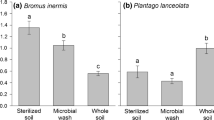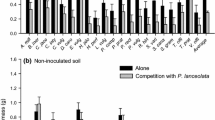Abstract
Arbuscular mycorrhizal fungi (AMF) associations benefit host plants due to increased ability to obtain resources and hence may influence competitive interactions. Here we experimentally examine growth in Cabralea canjerana and Lafoensia pacari at different densities and with and without AMF. In the density treatment pots had either six or 12 individuals. Half of each treatment was innoculated with AMF and the other half was not. The proportion of each species in each pot was also varied. The AMF did not apparently influence interspecific competitive interactions because growth was similar in both treatments. However, intra-specific competition was very strong in C. canjerana while more moderate in L. pacari and both were influenced by the presence of the AMF. The AMF—Cabralea canjerana interaction was parasitic, while AMF—L. pacari interactions were mutualistic. Thus, dependence upon AMF and intraspecific interactions that result as a consequence of that dependence varies among species and may be an important influence in community structure.


Similar content being viewed by others
Abbreviations
- AMF:
-
arbuscular mycorrhizal fungi
- ANOVA:
-
analysis of variance
- C:
-
carbon
- C. canjerana :
-
Cabralea canjerana
- Cii :
-
development (biomass) of species i when grown in monoculture
- Cij :
-
development (biomass) of species i when grown in mixture with species j
- Cji :
-
development (biomass) of species j when grown in mixture with species i
- Cjj :
-
development (biomass) of species j when grown in monoculture
- FURB:
-
Universidade Regional de Blumenau
- H2O2 :
-
hydrogen peroxide
- HCl:
-
Hydrochloric acid
- KOH:
-
potassium hydroxide
- L. pacari :
-
Lafoensia pacari
- M:
-
mycorrhizal plants
- NM:
-
non-mycorrhizal plants
- P:
-
phosphorus
- RY:
-
relative yields
- TD:
-
total density
References
Allen MF (1996) The ecology of mycorrhizae. Cambridge University Press, Australia
Allen EB, Allen MF (1990) The mediation of competition by mycorrhizae in successional and patchy environments. In: Grace JB, Tilman GD (eds) Perspectives on plant competition. Academic, New York, pp 367–389
Allen MF, Allen EB, Friese CF (1989) Responses of the non-mycotrophic plant Salsola kali to invasion by vesicular arbuscular mycorrhizal fungi. New Phytol 111:45–49
Begon M, Mortimer M, Thompson DJ (1996) Population ecology. Blackwell Science, Cambridge
Bethlenfalvay GJ, Brown MS, Pacovsky RS (1982) Parasitic and mutualistic associations between a mycorrhizal fungus and soybean: development of the host plant. Phytopathology 72:889–893
Carneiro MAC, Siqueira JO, Davide AC, Curi LJGN, Vale FR (1996) Fungo Micorrízico e superfosfato no crescimento de espécies arbóreas tropicais. Scientia Forestalis 50:21–36
Chapin FS, Walker LR, Fastie CL, Sharman LC (1994) Mechanisms of primary succession following deglaciation at Glacier Bay, Alaska. Ecol Monogr 64:149–175
Dodd JC, Boddington CL, Rodriguez A, Gonzalez-Chavez C, Mansur I (2000) Mycelium of arbuscular Mycorrhizal Fungi (AMF) from different genera: form, function and detection. Plant Soil 226:131–151
Francis R, Read DJ (1994) The contribuitions of mycorrhizal fungi to the determination of plant community structure. Plant Soil 159:11–25
Giovanetti M, Mosse B (1980) An avaluation of techniques for measuring vesicular-arbuscular mycorrhizal infection in roots. New Phytol 84:489–500
Hart MM, Reader RJ, Klironomos JN (2003) Plant coexistence mediated by arbuscular mycorrhizal fungi. Trends Ecol Evol 18:418–423
Hartnett DC, Wilson GWT (2002) The role of mycorrhizas in plant community structure and dynamics: lessons from grasslands. Plant Soil 244:319–331
Hartnett DC, Hetrick BAD, Wilson GWT, Gibson DJ (1993) Mycorrhizal influence on intra- and interspecific neighbour interactions among co-occuring prairie grasses. J Ecol 81:787–795
Hetrick BAD, Wilson GWT, Hartnett DC (1989) Relationship between mycorrhizal dependency and competitive ability of two tallgrass prairie grasses. Can J Bot 67:2608–2615
Hetrick BAD, Hartnett DC, Wilson GWT, Gibson DJ (1994) Effects of mycorrhizae, phosphorus availabiliy, and plant density on yield relationsships among competing tallgrass prairie grasses. J Bot 72:168–176
Janos DP (1980) Mycorrhizae influence tropical succession. Biotropica 12:56–64
Johnson NC, Graham JH, Smith FA (1997) Functioning of mycorrhizal associations along the mutualism-parasitism continuum. New Phytol 135:575–585
Jones MD, Smith SE (2004) Exploring functional definitions of mycorrhizas always 1 mutualisms? Can J Bot 82:1089–1109
Khalil S, Loynachan TE, Tabatabai MA (1999) Plant determinants of mycorrhizal dependency in soybean. Agron J 91:135–141
Koide R (1985) The Nature og growth depressions in sunflower caused by vesicular-arbuscular mycorrhizal infection. New Phytol 99:449–462
Koske RE, Gemma JN (1989) A modified procedure for staining roots to detect VA mycorrhizas. Mycol Res 92:486–488
Kytöviita MM, Vestberg M, Tuomi J (2003) A test of mutual aid in common mycorrhizal networks: established vegetation negates benefit in seedlings. Ecology 84:898–906
Marschner H (1995) Mineral nutrition of higher plants. Academic, London
Newsham KK, Fitter AH, Watkinson AR (1995) Arbuscular mycorrhiza protect an annual grass from root pathogenic fungi in the field. J Ecol 83:991–1000
Oliveira RS, Castro PML, Dodd JC, Vosátka M (2005) Synergistic effect of Glomus intraradices and Frankia spp. on the growth and stress recovery of Alnus glutinosa in an alkaline anthropogenic sediment. Chemosphere 60:1462–1470
Oliveira RS, Castro PML, Dood JC, Vosátka M (2006) Different native arbuscular mycorrhizal fungi influence the coexistence of two plant species in a highly alkaline anthropogenic sediment. Plant Soil 287:209–221
Ozinga WA, van Andel J, Mcdonnell-Alexander MP (1997) Nutritional soil heterogeneity and mycorrhiza as determinants of plant species diversity. Acta Bot Neerl 46:237–254
Pasqualini D, Uhlmann A, Stürmer S (2007) Arbuscular mycorrhizal fungal communities influence growth and phosphorus concentration of woody plants species from the Atlantic rain forest in South Brazil. Forest Ecol Manag 245:148–155
Pedersen CT, Sylvia DM (1996) Mycorrhiza: Ecological implications for plant interactions. In: Mukerji KG (ed) Concepts in mycorrhiza. Kluwer, Dordrecht
Plenchette C, Fortin JA, Furlan V (1983) Growth response of several plants species to mycorrhiza in a soil of moderate P fertility. I. Mycorrhizal dependency under field conditions. Plant Soil 70:191–209
Siqueira JO, Franco AA (1988) Biotecnologia do solo, fundamentos e perspectivas. MEC/ABEAS/ESAL/FAEPE, Brasília
Siqueira JO, Carneiro MAC, Curi N, Rosado SCS, Davide AC (1998) Mycorrhizal colonization and mycotrophic growth of native woody species as related to successional groups in Southeastern Brazil. Forest Ecol Manage 107:241–252
Smith FA, Smith SE (1996) Mutualism and parasitism: Diversity in function and structure in the “arbuscular” (VA) mycorrhizal symbiosis. Adv Bot Res 22, Academic
Smith SE, Read DJ (1997) Mycorrhizal symbiosis. Academic 1, New York
Sylvia DM, Williams SE (1992) Vesicular-arbuscular mycorrhizae and environmental stresses. In: Bethlenfalvay GJ, Linderman RG (eds) Mycorrhizae in sustainable agriculture. ASA, Madison, pp 101–124
Sylvia DM, Alagely AK, Chellemi DO, Demchenko LW (2001) Arbuscular mycorrhizal fungi influence tomato competition with bahiagrass. Biol Fertil Soils 34:448–452
Thingstrup I, Rubaek G, Sibbesen E, Jakobsen I (1998) Flax (Linum usitatissimum L.) depends on arbuscular mycorrhizal fungi for growth and P uptake at intermediate but not high soil P levels in the field. Plant Soil 203:37–46
Tilman D (1982) Resource competition and community structure. Princeton University Press, Princeton
van der Heijden MGA (2002) Arbuscular mycorrhizal fungi as a determinant of plant diversity: In search of underlying mechanisms and general principles. In: van der Heijden MGA, Sanders IR (eds) Mycorrhizal ecology. Springer, Berlin, pp 243–265
van der Heijden MG, Wiemken A, Sanders IR (2003) Different arbuscular mycorrhizal fungi alter coexistence and resource distribution between co-occurring plant. New Phytol 157:569–578
Wright SF, Upadhyaya AA (1998) Survey of soils for aggregate stability and glomalin, a glycoprotein produced by hyphae of arbuscular mycorrhizal fungi. Plant Soil 198:97–107
Zangaro W, Bononi VLR, Trufem SFB (2000) Mycorrhizal dependency, inoculum potential and habitat preference on native woody species in South Brazil. J Trop Ecol 16:603–621
Zangaro W, Nisizaki SMA, Domingos JCB, Nakano EM (2003) Mycorrhizal response and successional status in 80 woody species from south Brazil. J Trop Ecol 19:315–324
Zobel M, Moora M (1995) Interespecific competition and arbuscular mycorrhiza: importance for the coexistence of two calcareous grassland species. Folia Geobot 30:223–230
Acknowledgements
We thank the Universidade Regional de Blumenau (FURB) for its support, as well as its Botany, Biotechnology, Immunology and Zoology laboratories and the Chemistry Department, for their support and use of their facilities. Thanks to professors Geraldo Moretto and Carlos Efrain for their help with statistics. Thanks to the Tutorial Education Program (PET/Biologia) for the financial support and the incentive for research that it enabled. James J. Roper translated this text from the original Portuguese.
Author information
Authors and Affiliations
Corresponding author
Additional information
Responsible Editor: Angela Hodge.
Rights and permissions
About this article
Cite this article
Danieli-Silva, A., Uhlmann, A., Vicente-Silva, J. et al. How mycorrhizal associations and plant density influence intra- and inter-specific competition in two tropical tree species: Cabralea canjerana (Vell.) Mart. and Lafoensia pacari A.St.-Hil.. Plant Soil 330, 185–193 (2010). https://doi.org/10.1007/s11104-009-0191-y
Received:
Accepted:
Published:
Issue Date:
DOI: https://doi.org/10.1007/s11104-009-0191-y




